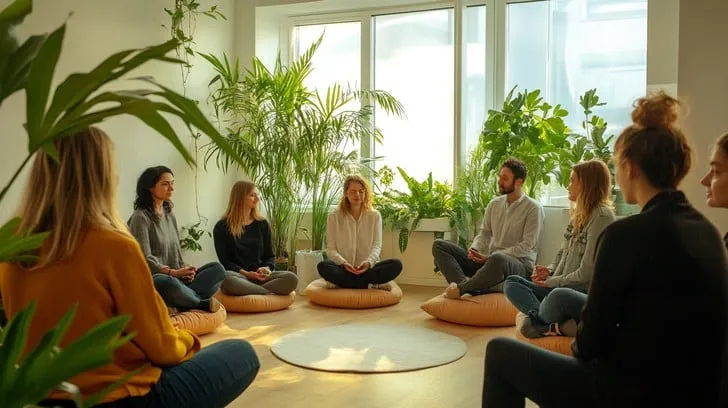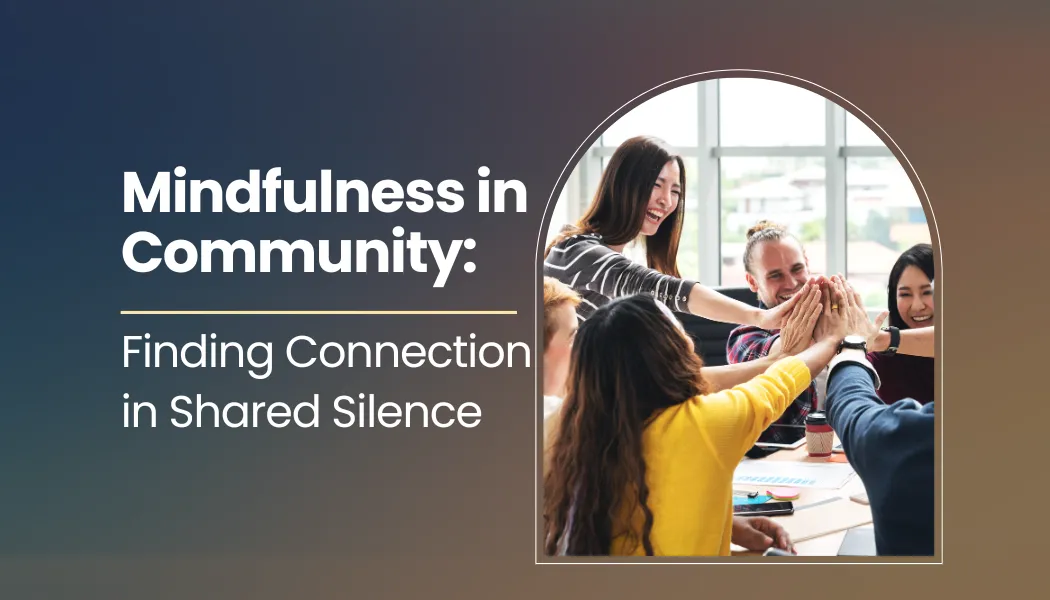Introduction: The Quiet Power of Togetherness
In today’s fast-paced, hyperconnected world, silence is often hard to find. Our days are filled with conversations, notifications, and endless streams of information. Yet, there is a growing recognition that silence is not emptiness—it is nourishment. Silence gives the mind space to rest, the heart space to feel, and the spirit space to expand.
When practiced alone, mindfulness can bring inner calm and awareness. But when practiced in a community—especially through shared silence—mindfulness opens a doorway to something deeper: connection. Beyond words, silence becomes a common language of presence, reminding us that we are not isolated individuals but threads in a larger human tapestry.
This article explores how mindfulness in community, particularly through shared silence, strengthens emotional bonds, nurtures belonging, and transforms collective healing.
The Essence of Mindfulness
Mindfulness is the simple yet profound act of paying attention, on purpose, in the present moment, without judgment. It is noticing the breath, the body, emotions, and thoughts as they arise. While many discover mindfulness through personal meditation, traditions across cultures have long emphasized the collective aspect.
Buddhist sanghas, Christian contemplative orders, Quaker meetings, Sufi gatherings—all embrace silence together as a path toward awakening, compassion, and unity. In community practice, mindfulness is not just about my breath or my thoughts, but about the shared experience of presence.
Why Silence in Community Feels Different
1. A Shared Atmosphere of Calm
When people gather to sit quietly, the stillness is amplified. Each person contributes to an atmosphere of peace, making it easier for everyone to settle into awareness. Silence becomes a shared gift.
2. Connection Beyond Words
In silence, social masks and labels fall away. Without the need for small talk, individuals often feel more authentic and less pressured. Sitting silently side by side, we realize our common humanity.
3. Collective Energy and Support
Alone, it is easy to get distracted or restless. In community, the presence of others strengthens resolve. The shared energy acts as a gentle reminder to stay present.
4. Healing from Loneliness
Modern society struggles with isolation and loneliness. Shared silence offers connection without performance. Simply being together is enough.
The Science of Collective Mindfulness
Recent studies in psychology and neuroscience show that mindfulness practiced in groups has unique benefits:
- Synchrony of Brain Waves: Research suggests that people meditating together show greater synchronization in brain activity, fostering empathy and trust.
- Lower Stress Hormones: Collective practices reduce cortisol, enhancing relaxation.
- Enhanced Compassion: Group mindfulness increases prosocial behavior, making people more likely to help and care for others.
- Stronger Commitment: Practicing in community increases accountability and makes mindfulness a sustainable habit.
Historical Roots of Shared Silence
Buddhist Sanghas
For over 2,500 years, Buddhist practitioners have gathered in communities (sanghas) for meditation. Silence here is a path to awakening, compassion, and insight.
Quaker Meetings
In the Quaker tradition, communities gather in silence, waiting for inner guidance. Their “meetings for worship” demonstrate that silence can be both sacred and democratic.
Indigenous Traditions
Many Indigenous cultures honor silence in rituals, storytelling, and nature connection. Silence is not absence but listening—to the earth, to ancestors, to spirit.
Modern Adaptations
Retreat centers, mindfulness groups, and even corporate wellness programs now use shared silence to foster resilience and collaboration.
Practices of Shared Silence

1. Silent Group Meditation
Participants gather, often seated in a circle, and focus on breathing or body awareness. The collective stillness deepens individual awareness.
2. Walking Meditation
A group walks slowly and mindfully, often outdoors, paying attention to each step. Walking together in silence creates a rhythm of unity.
3. Silent Meals
Eating in silence as a group heightens gratitude and presence. Every bite becomes an act of mindfulness, shared without words.
4. Silent Retreats
Ranging from a day to several weeks, retreats offer immersive shared silence. People often report leaving with profound clarity and connection.
5. Community Rituals
Lighting candles, sitting in circles, or holding silent vigils are ways communities use silence to honor events, grieve losses, or celebrate peace.
Case Studies: Silence in Action
Case 1: A Workplace Experiment
A large company introduced weekly 15-minute silent breaks for employees. Staff reported reduced stress, stronger team cohesion, and fewer conflicts.
Case 2: School Mindfulness Circles
In a high school in California, students begin each week with a silent mindfulness circle. Teachers observed better focus, less bullying, and a stronger sense of belonging among students.
Case 3: Community Healing After Tragedy
After a natural disaster in Japan, survivors gathered in silent vigils. Many said the silence brought comfort and solidarity when words felt inadequate.
Overcoming Barriers to Shared Silence
Restlessness or Discomfort
Silence can feel awkward at first. Communities overcome this by starting small—just a few minutes—and gradually extending the duration.
Fear of Vulnerability
Some worry about being judged. Facilitators can create safe spaces by reminding participants that silence is about presence, not performance.
Cultural Resistance
In cultures that prize constant activity, silence may seem unproductive. Education about its benefits helps normalize the practice.
Benefits of Mindfulness in Community
Emotional Healing
Shared silence allows unspoken feelings to surface in a safe environment. Many people experience reduced anxiety and deeper acceptance.
Building Compassionate Communities
When we sit silently together, we practice patience and empathy. Communities become more cohesive and compassionate.
Deepening Spiritual Life
Regardless of religious background, shared silence connects people to something larger than themselves—a sense of the sacred or the interconnected web of life.
Collective Resilience
Communities that practice silence together develop stronger resilience during crises. They are better able to support one another and adapt.
Integrating Shared Silence into Daily Life
- Start a Weekly Silent Circle: Gather friends, family, or neighbors for 10–20 minutes of silence.
- Silent Meals at Home: Dedicate one meal a week to mindful eating together.
- Mindful Commuting: Encourage group silence during carpools or train rides.
- Community Events: Add moments of shared silence before or after meetings, ceremonies, or public gatherings.
- Virtual Silence: Even online, communities can sit together silently with cameras on, feeling connected across distances.
The Future of Shared Silence
As societies grow busier and noisier, the value of silence will only increase. Future community design may include “silence spaces” in workplaces, schools, and public areas. Shared silence could become a vital practice for healing divisions, fostering inclusion, and nurturing mental health.
Conclusion: Together in Quiet
Mindfulness is often thought of as a solitary practice, but silence has always been communal too. When we sit quietly together, something profound happens. We realize that presence is not just personal—it is collective. In silence, we touch the truth that while our thoughts and stories may differ, our breath, our hearts, and our longing for peace are shared.
Shared silence is not about withdrawing from life—it is about reentering it with deeper awareness, compassion, and connection. In community, silence is not empty—it is full of possibility.
